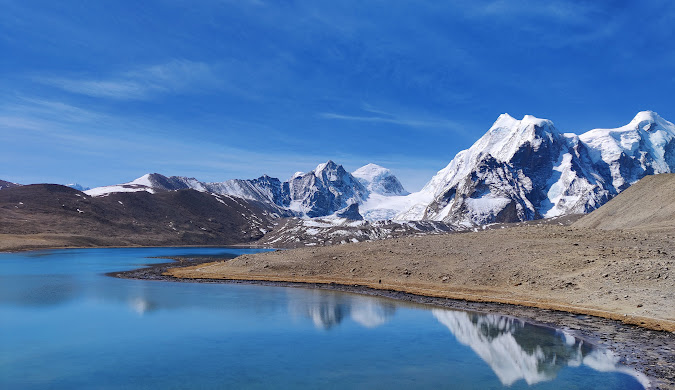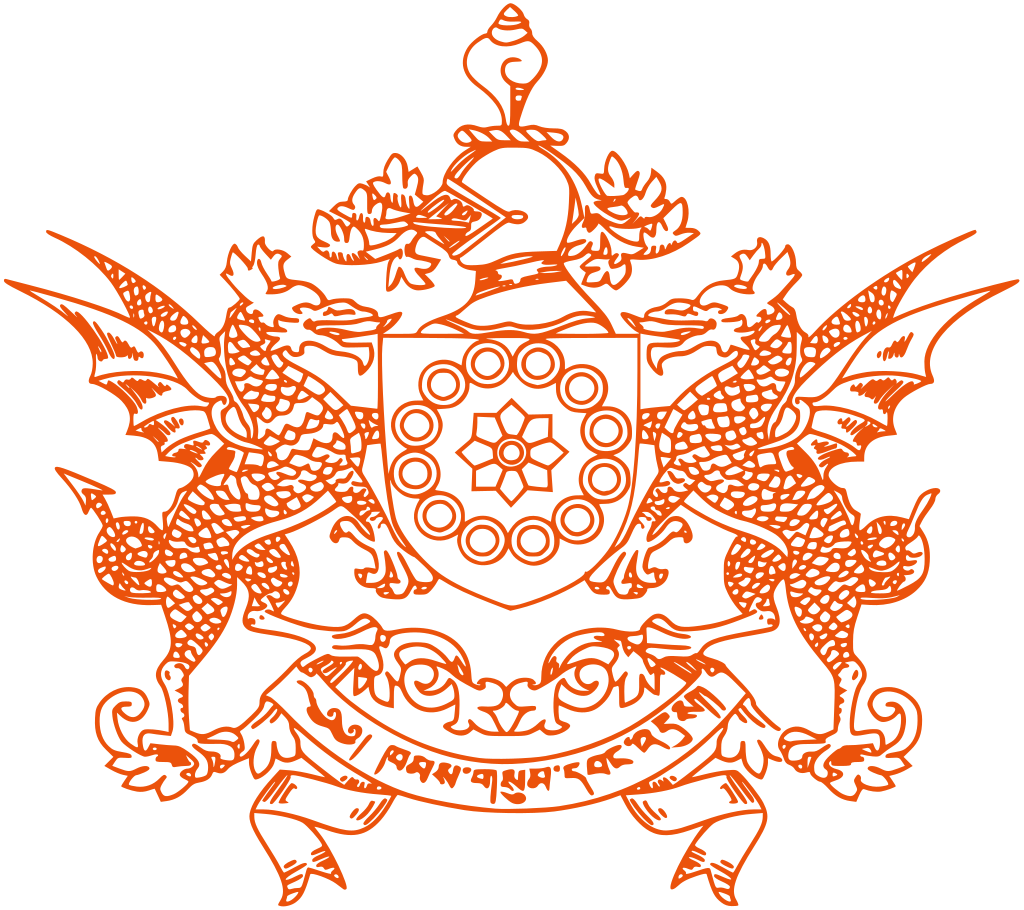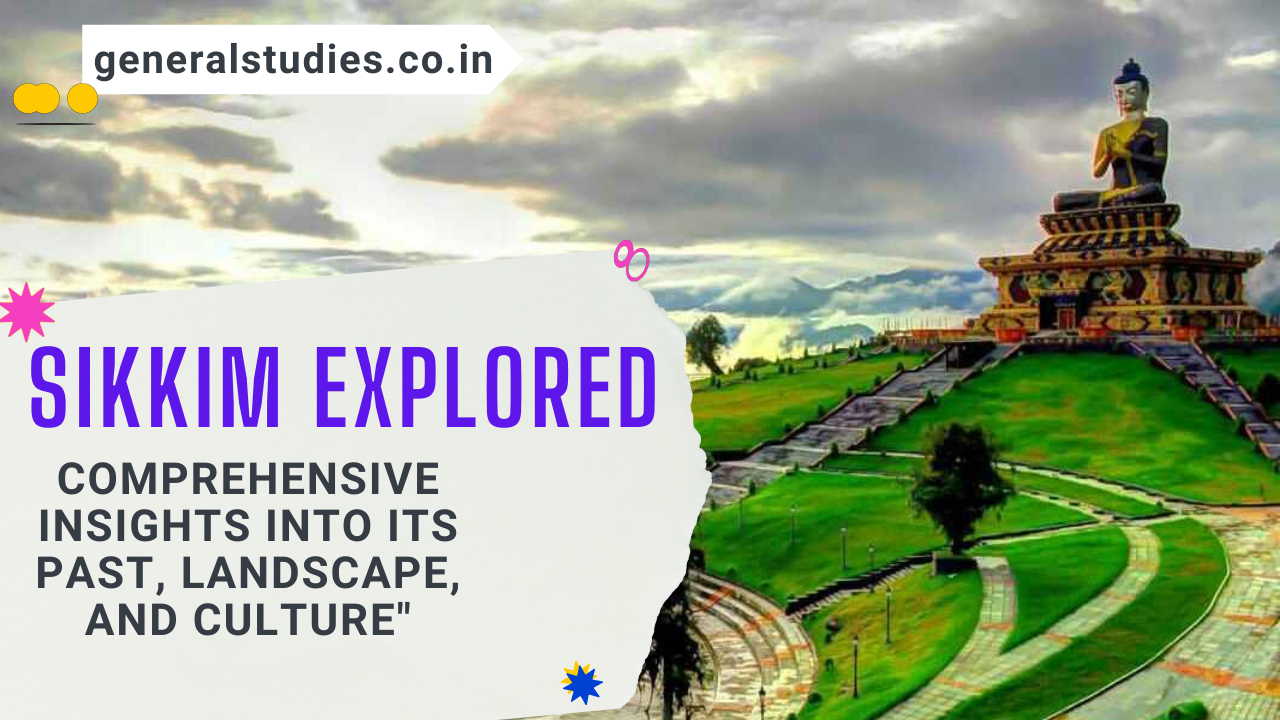Table of Contents
- Sikkim is a state in the Northeastern part of India.
- It shares its borders with the Tibet Autonomous Region of China in the north and northeast, Bhutan in the east, Nepal in the west, and West Bengal in the south.
- Sikkim is the least populous and second smallest among the Indian states.
- Sikkim’s capital is Gangtok.
- The official languages of the state are English, Nepali, Sikkimese, and Lepcha.
- Additional official languages: Gurung, Limbu, Magar, Mukhia, Newari, Rai, Sherpa, Tamang
State at a Glance

| Category | Details |
|---|---|
| Emblem of Sikkim |  |
| The Emblem was designed in 1877 by Robert Taylor. earlier used as the coat of arms of the Kingdom of Sikkim. | |
| Capital | Gangtok |
| Official Language | 11 official languages including English |
| Population | Approximately 6.1 lakhs (as per the 2011 Census) |
| Population Density | 86/km2 |
| Sex ratio (2011) | 890/1000 |
| Area | 7,096 km2 |
| Borders | National: West Bengal (south), International: Nepal (west), Bhutan (east), Tibet (north), |
| Highest Point | Kanchenjunga (8,586 meters) |
| Literacy Rate | 81.42% (as per the 2011 Census) |
| Major Rivers | Teesta, Rangit |
| Major Tribes | Lepcha, Bhutia, Limbu, Nepali |
| Monasteries | Rumtek Monastery (Gangtok) Pemayangtse Monastery (West Sikkim) Tashiding Monastery (West Sikkim) Enchey Monastery (Gangtok) |
| Waterfalls | Seven Sisters Waterfall (Near Gangtok) Banjhakri Falls (Gangtok) Rimbi Waterfalls (Pelling) |
| Lakes | Tsomgo Lake (Near Gangtok, fed by Teesta River) Gurudongmar Lake (North Sikkim, one of the highest lakes in the world) Khecheopalri Lake (West Sikkim, considered sacred) |
| Major Tourist Places | Gangtok (Capital, known for its scenic beauty and monasteries) Pelling (Famous for views of Kanchenjunga) Lachung (Gateway to Yumthang Valley) Nathula Pass (Border crossing into Tibet) Yumthang Valley (Known as the Valley of Flowers) |
| Cuisines | Momos (Steamed dumplings) Thukpa (Noodle soup) Gundruk (Fermented leafy greens) Kinema (Fermented soybeans) Phagshapa (Pork dish with radish) Sel Roti (Sweet rice bread) |
| Major Festivals | Losar (Tibetan New Year) Saga Dawa (Buddha’s life events) Maghe Sankranti (Harvest festival) Dasain (Nepali festival of victory) |
| Economy | Agriculture, tourism, hydroelectric power |
State Formation
- Sikkim was an independent kingdom before joining India.
- The Namgyal dynasty established its rule in 1642, with Phuntsog Namgyal as the first Chogyal (king).
- Sikkim remained a monarchy under the Chogyal kings, maintaining its independence even during British colonial rule.
- In 1975, political unrest and demands for democratic reforms led to a referendum.
- The people of Sikkim overwhelmingly voted in favor of joining India.
- On May 16, 1975, Sikkim became the 22nd state of India. The monarchy was abolished.
Brief History
- Sikkim has always been a strategic location between Tibet, Bhutan, and Nepal. The region has always been a land of diversity, deeply influenced by Tibetan Buddhism and its neighboring regions.
- The Namgyal dynasty was established in 1642 by Phuntsog Namgyal [Chogyal (king)] which marked the beginning of Sikkim as a kingdom.
- During the 18th and 19th centuries, Sikkim faced invasions from Nepal and Bhutan, leading to territorial losses.
- In 1817, the Treaty of Titalia was signed with the British, restoring Sikkim’s sovereignty but also bringing it under British protection. Sikkim continued to be a protectorate until India gained independence in 1947.
- After India’s independence, Sikkim’s political situation became increasingly complex, with growing demands for democracy. In 1975, a referendum was held in Sikkim, where the majority of the people voted in favor of joining India.
- The monarchy was ultimately abolished, and Sikkim became a full-fledged state of India in 1975.
Geography
Sikkim is a small but geographically diverse state located in the northeastern part of India. Despite its size, the state has a wide range of physical features, from high mountains to deep valleys. Sikkim is divided into four main physiographic regions:
1. Northern Mountains (High Himalayas)
- Physical Features: This region includes some of the highest peaks in the world, including Mount Kanchenjunga(8,586 meters). It is the third-highest mountain in the world.
- Topography: The terrain is rugged and steep, with glaciers, sharp peaks, and deep gorges.
- Terrain: This region is characterized by alpine meadows, snowfields, and glaciers. Sikkim has 84 glaciers, the largest number as compared to any other state or union territory of India.
- Zemu Glacier: largest glacier in the Eastern Himalayas, 26 km in length.
- Rathong Glacier.
- Average Height: The average height of this region ranges from 4,000 meters to over 8,000 meters.
2. Central Himalayan Range
- Physical Features: The Central Himalayan Range lies south of the High Himalayas and is marked by high ridges and deep valleys. The Tista River cuts through this region, forming the main river valley in Sikkim.
- Topography: The topography here is less rugged compared to the Northern Mountains, but still includes high ridges and deep valleys. The slopes are heavily forested, and there are numerous streams.
- Terrain: The terrain is a mix of dense forests, cultivated terraces, and river valleys.
- Average Height: The average height of this region ranges from 1,500 meters to 4,000 meters.
3. Southern Hills
- Physical Features: The Southern Hills region is characterized by lower hills and valleys. It includes the foothills of the Himalayas and the outer ranges.
- Topography: The topography is gentler compared to the northern regions, with rolling hills, wide valleys, and terraced farming areas.
- Terrain: The terrain is a mix of forested areas, agricultural land, and small settlements. The region is more accessible and has a warmer climate.
- Average Height: The average height of the Southern Hills ranges from 300 meters to 1,500 meters.
4. River Valleys
- Physical Features: The major river valleys in Sikkim include the Tista and Rangit rivers.
- Geology: The river valleys are composed of alluvial deposits and are characterized by fertile soil.
- Terrain: The terrain is predominantly agricultural, with paddy fields, vegetable farms, and fruit orchards. The valleys also serve as major transport routes.
- Average Height: The average height of the river valleys ranges from 200 meters to 1,000 meters.
Art & Culture
- Monastic Dances (Chaams): These traditional mask dances are an essential part of Sikkim’s cultural heritage. Performed during religious festivals and ceremonies, Chaams symbolize the victory of good over evil. Dancers wear elaborate masks of dragons, animals, and mythical creatures, dressed in richly embroidered costumes. The dances are accompanied by the rhythmic sounds of cymbals, drums, and long horns, creating a mesmerizing spectacle.
- Thangka Paintings: Thangkas are intricate religious scrolls that depict Buddhist deities, symbols, and narratives. These hand-painted works of art serve as aids for meditation and are often used in religious rituals. The vibrant colors and detailed iconography of Thangkas reflect the deep spiritual and artistic traditions of Sikkim.
- Handicrafts: Sikkim is known for its traditional handicrafts, including wood carvings, woven carpets, and handloom textiles. The Lepcha and Bhutia communities are particularly skilled in creating these crafts, which are not only functional but also carry cultural significance.
- Festivals: Sikkim’s festivals are a colorful celebration of its rich cultural tapestry. Losar (Tibetan New Year) is one of the most important festivals, marked by Chaam dances, feasting, and prayers. Other significant festivals include Saga Dawa, which commemorates the life of Buddha, and Maghe Sankranti, a harvest festival celebrated by the Nepali community.
- Cuisine: Sikkimese cuisine is a reflection of its diverse cultural influences. The staple food includes rice, lentils, and vegetables, often accompanied by fermented foods like gundruk (fermented leafy greens) and kinema (fermented soybeans). Momos (dumplings) and thukpa (noodle soup) are popular dishes that have Tibetan origins.

